I recently watched a talk from the Game Developers Conference in 2018, and the title says it all: "Game Design Patterns for Building Friendships". The speaker (Daniel Cook, Chief Creative Office of Spry Fox) is a game designer with a focus on making happiness. His talk hits on meaningful relationships, friendships in particular.

There's def a lot to pull here for the Relational Operating System we've been talking about, and Buzzard generally. So, here's a mashup of excerpts (screenshots) and summary from the talk, and some notes from yours truly.
Ok, so the basic overview is there are 4 laws of #friendship formation:
- Proximity
- Similarity
- Reciprocity
- Disclosure
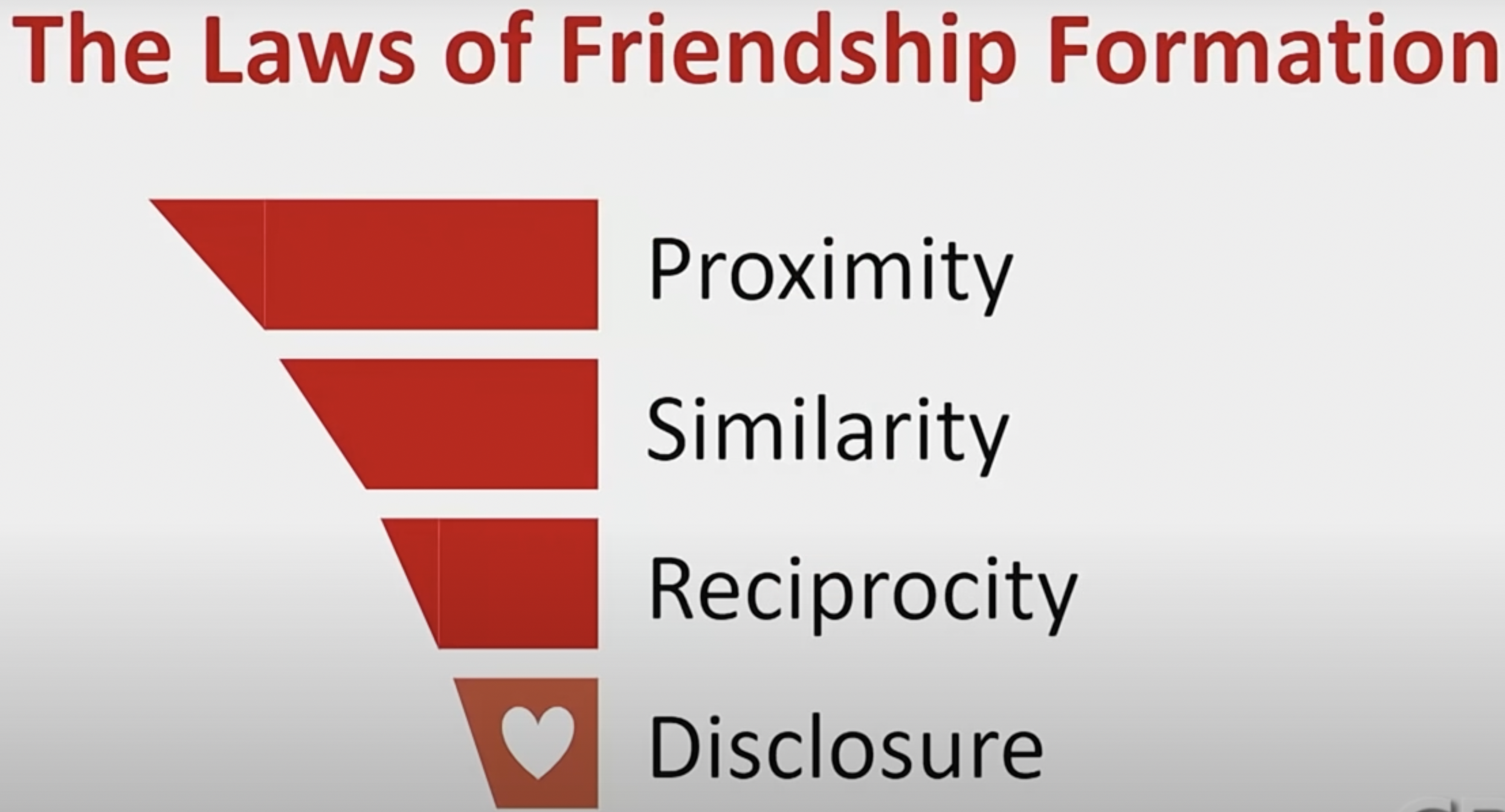
I think another way of visualizing this is a pyramid, kind of like a hierarchy of needs sort of thing, or the food pyramid. Here's another take at the 4 laws of friendship, pyramid-style

With this visualization, it's more clear that proximity is foundational, and something plentiful. In friendship game design, proximity is a must--after all, you can't be friends with someone if you can't interact with them. All the way up to disclosure, which really seals the friendship deal, but isn't necessary in all friendship endeavors. One way of thinking about this is, disclosure from the get-go isn't typically a great social dynamic to gamify. But used at the right time, in the right way, helps solidify a friendship.
So let's explore Daniel's friendship deign by starting at the base of the pyramid and working our way up.
Proximity
Proximity, or propinquity in social psychology, refers to nearness to another person. In order to maximize serendipity, this social distance needs to be accounted for, and in friendship games, we want repeat serendipity interactions.
Interestingly, this is where we start getting into logistics and math (the talk is not very technical, however)--there's plenty of details that I won't share here, but suffice to say, this stuff is definitely programmable. Much of the math has to do with density of people, and interactions.
Essentially, designing different games or features that drive changes in density: want large scale, intense density for a short period? Create an event. Want repeat encounters over a longer period of time in a relaxed setting? Create an offline community or daily challenges.
My take away here is: think about people in terms of flow, movement. A game based on friendship-design will move folks through a system and adjust proximity as necessary to hold a certain density of interaction.
Also, proximity and repeat serendipity help to build a persistent identity; it's critical to give people repeat opportunities to show up and interact.
Additional proximity thoughts
- I think this dovetails nicely with some of the lineage (of 3rd object) discussions we've had, and also how some of the Relational games will produce content that can be used to populate a profile.
- There may be a tie here to when we're on-chain vs. off-chain (aka blockchain). Games may produce data you decide can be part of your identity structure (also: how do we decide what is identity-data and what is not?), this feels important, should this be stored on-chain? As opposed to data that is simply relational, emergent, exploratory--you know, the "data" we barf out trying to express our identity.
- It may be that the Relational OS is helping people unearth their "true identity" (though I really don't like this terminology)--in a nutshell, it's hard to figure out who you are and express it, Relational OS helps with this.
There's a few proximity things to watch out for, aka anti-patterns
- Anonymity - I don't have notes on why this is an anti-pattern, but my sense is that anonymity doesn't foster building trust. There's a lack of accountability. There's something here I'm feeling into regarding abandonment too--where an anonymous person can bail at any time, leaving "friends" behind. Investing in an anonymous person who doesn't have a clear identity doesn't sound enticing.
- Matchmaking - the biggest challenge here is long wait times, you don't want people waiting in your system to engage
- Too many game-play modes - this is a density (proximity), or serendipity, challenge; don't want people too spread out unnecessarily
- Separating players by skill - see above, a density, or serendipity, challenge
Some proximity patterns to explore for friendship design
- In lieu of matchmaking, which includes cohort matching, a useful flow pattern is to create active spaces where folks can engage in activities whenever they join, even if they're alone.
- This gives the option for people to come and go as they please. It also gives the opportunity to design for some kind of "event" to emerge if there's a certain number people in the room - think: "hey! there's 10 people in the room! let's play a (collaborative) game of..."
- Spaces that aren't active: design ways to funnel people to other, more active, spaces. There's a few ways to do this, along a continuum: kill instances where there isn't a lot of activity (force movement) <--> incentivize voluntary migration.
- I'm not sure how this would work with what we're doing... I think it will be more obvious when we have more movement in the system (not sure right now where people would be moving to and from; this is where we're less like a videogame - people don't have to be in constant play, that's not the point--I don't think?)
Similarity
Succinctly described as the perception of shared cultural norms. The goal here is to use the fact that people gravitate towards people like themselves. This is because there's a lower cost of social negotiation when people are like us.
Be careful though! Too much reliance on continuously funneling people towards folks who are similar can result in an anti-pattern of something equivalent to xenophobia or nationalism. Don't want to create too much of a closed feedback loop, where an in-group is continuously feeding itself without outside influx of interaction.
Tools that use similarity in game design allow us to create positive, fictional, identities (I'm curious how we'll lean into the fictional side of things, I think a fair amount). For example:
- Developing pro-social roles. I think there's a lot of room to explore pro-social roles in Relational OS and Buzzard.
- One of the examples given was the concept of tend-and-befriend, a style of behavior that is often exhibited more in women than men, where stress or threat leads to:
- Tending - protect and nurture offspring
- Befriending - seeking out a social group for mutual support. This is interesting in and of itself--how do we nudge people towards taking care of each other or seeking group support when feeling stressed?
- Creating fictional cultures - we're using this now to instantiate Buzzard and Relational OS in the first place. We're calling it "design fiction" with the same premise - a way to come together and work towards building something.
- Curiously, in game design there's an imperative to NOT reference the real world directly. Not sure how to parse this with what we're building. How much of Buzzard is completely outside of the real world? This is one place where we may diverge from video game play but there's surely a lesson here to take from.
Reciprocity
Reciprocity has a lot to do with building trust through shared social norms. Take the context of similarity and layer on top: making a friendly offer and giving a positive response. Each time this happens - and it can be the most subtle (IRL - acknowledging someone with a wave, or nod, in passing and receiving a response), trust is built.
This building of trust is slow going, but with the right game play should be fun--at least in part. There's a fair amount of vulnerability when you're not sure what the social norms are, which means that participating on either side of reciprocity (the initiating or responding) can be challenging. And when trust is broken, and the social norms are broken, trust can be quickly lost. (This participation is akin to disclosure, see below; when disclosing oneself and rejected, this is when trust crashes quickly)

Something here excites me: the inherent risk of developing social norms, relationships, building trust. There's a dialectic here: taking risk and engaging in socially normative behavior, through this combo, there's an emergence of trust and friendship.
Tools and key aspects of reciprocity
- Creating a culture of predictable behaviors - there's a reason they're called social norms, norm means usually, typically... predictable. When I do X, Y happens (but you know, a bit more fluid given social dynamics). For something more complex than a video game, idk how to approach this. But I get the direction - this is culture development: in Relational OS, in Buzzard, we do things like X, Y, Z.
- In early onboarding, social norms can be taught through automated initial interactions. Facilitate cooperation and collaboration - we've already started talking about games like this. Shahruz mentioned the Taskmaster game show which is ripe for all kinds of games in this space (he said to watch seasons 5 or 7). Essentially we're talking about creating roles where the group fails if everyone isn't working together.
- Another way of putting it: non-zero sum guild rewards--there's no single winner takes all, it's a group that works together. Guilds in videogames are collaborative groups working together on some kind of mission or task.
- Interesting game dynamics in video games where you'll receive points when someone near you earns points. This is incentivizing your interest in what they're doing, and their success. I think we can definitely work with this dynamic. This also points to proximity again.
- It's worth noting that when a group of people are collaborating with highly differentiated roles, greater trust is needed. Something to keep in mind as we continue to build our motley crew--we'll need to build trust, a lot of it, as we go, because odds are, there's going to be a high degree of differentiation across the team (at least early days).
- This is what will make what we're building super interesting--lots of differentiated perspectives will cover broader ground while finding commonality and ways to come together. This is a more advanced friendship level (soft to hard cooperation: see more below on friendship leveling-in).
Anti-patterns: what to be wary of with reciprocity
- Humans are wired to reciprocate, which makes this behavior ripe for manipulation. An example of manipulation IRL is something like: you get free return address stickers from a non-profit, they're trying to manipulate reciprocity and ask you to donate to the organization.
- Not sure how this would come up in game play or in game design; perhaps there are ways to design our protocol with this in mind. Though I'm not naive to think we (humans) could create an OS to not allow manipulation completely.
- Lack of predictability - if people don't know what to expect after spending some time in a system, they're not going to want to come back because it probably won't be fun. It's not fun when you don't how you're supposed to act in a place. (Note: this relates to friendship leveling-in, if we want to grow and change, dynamics will evolve over time. We just don't want things moving too fast for individual people as they grow.)
- The use of power differentials - when people don't have a mutual need, those with less need (more power) may manipulate those with greater needs (less power). This power differential is not desirable.
- High initial interaction costs - make it easy in the beginning for people to figure out what's going on.
There are reciprocation tools (screenshot below) that the speaker warns we should be careful with using, very intentional about how we use these tools. Lest we end up driving engagement because it looks good to have metrics rising (aka all social media tools now)--it's not only about engagement but healthy engagement

My main take away for reciprocity: design a protocol that intentionally levels up friendships, increasingly builds trust over time, and allows people to learn and grow at a comfortable pace.
Disclosure
Disclosure is at the top of the pyramid because it's intense! There's typically a need to build up some trust before disclosing vulnerable information. But the name of the friendship game is just that: revealing weaknesses creates the strongest bonds.
This is that same dialectic I mentioned earlier: share vulnerability about self and hope that you'll be accepted within the social norms that you've navigated so far. What can emerge here is growth and friendship.
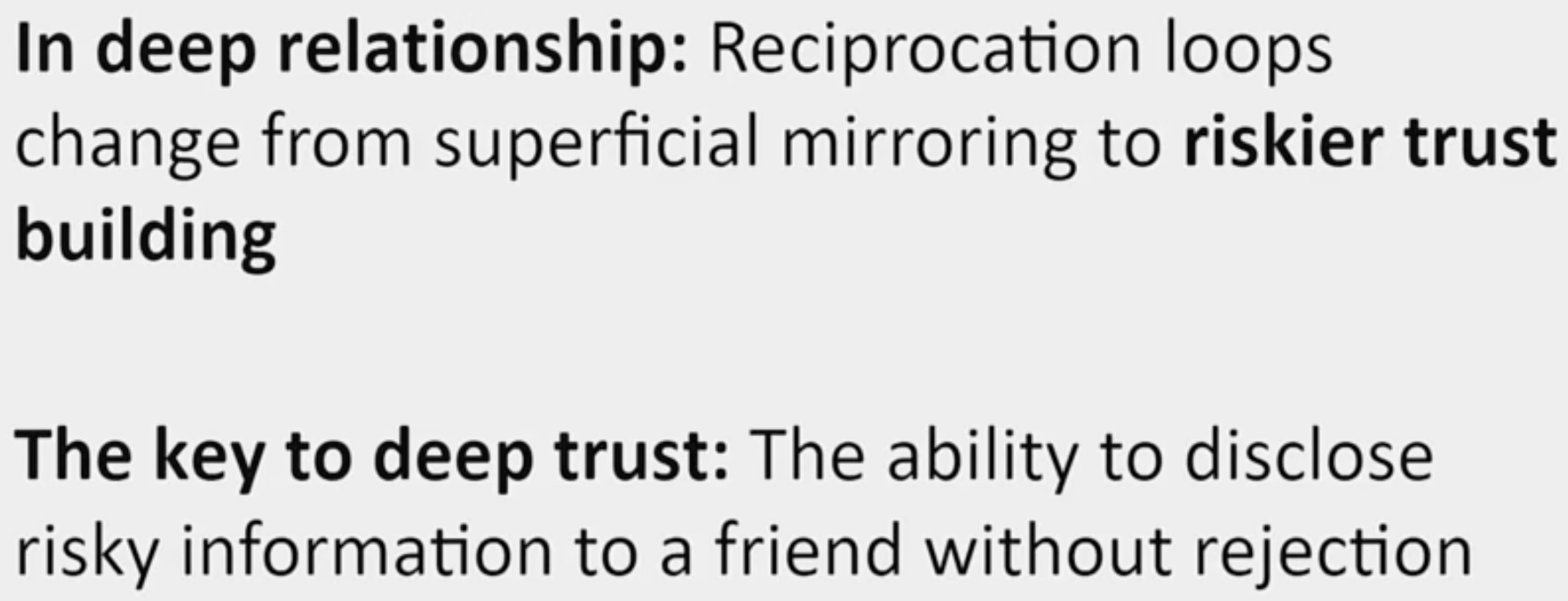
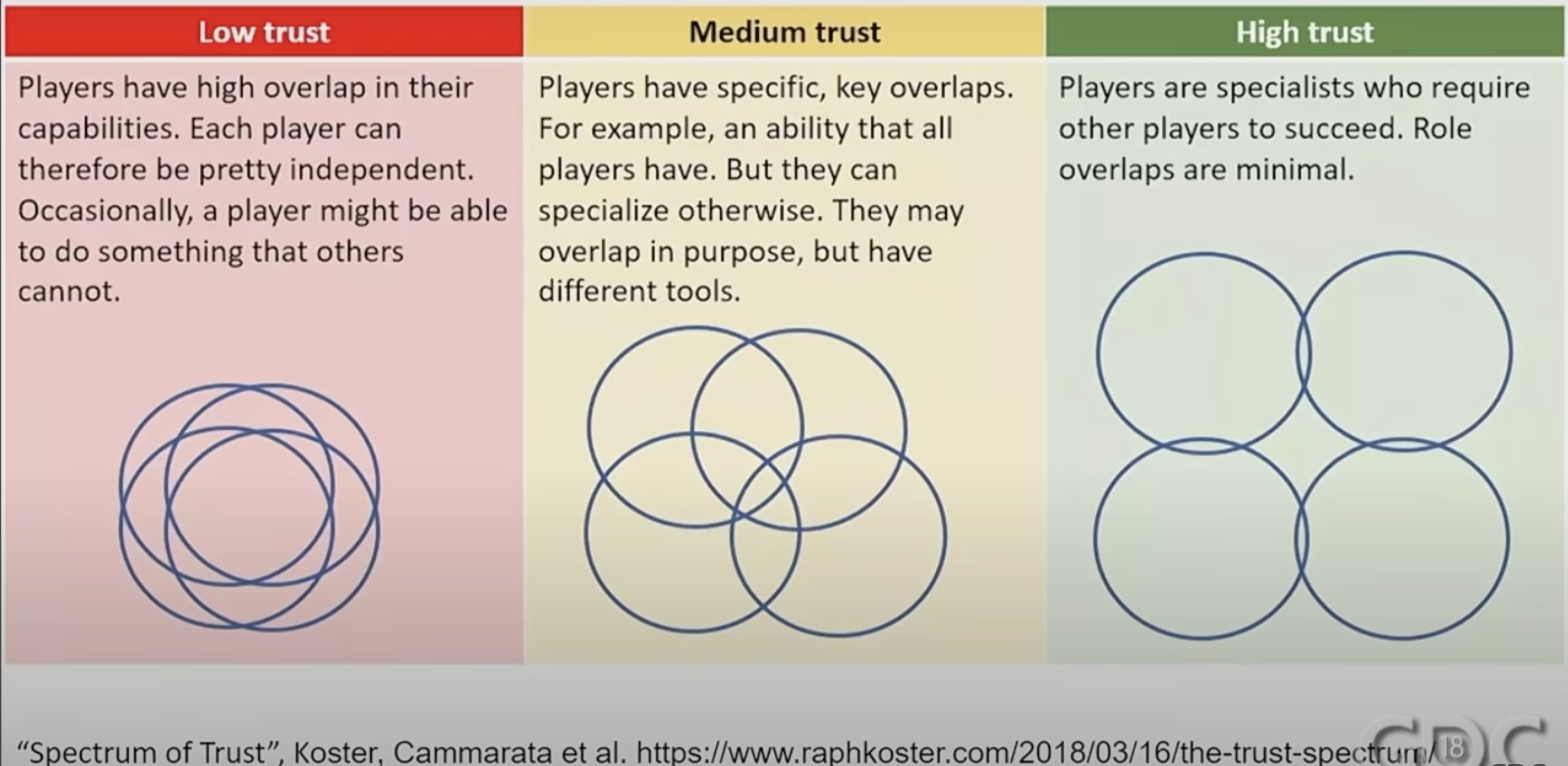
Disclosing too much, too early, or too often, kills friendships. This means trust is lost and has to be regained. So building in disclosure over time is a good idea. As is giving people small, private arenas for disclosure - sharing something intimate shouldn't be required to the entire group at-large.
Another anti-pattern with disclosure is revealing too much too soon. Without finding common ground, this can trigger a kind of fear-based reaction. So need to have a leveling-in of disclosure as people progress through friendship levels (see the following section on levelling in) 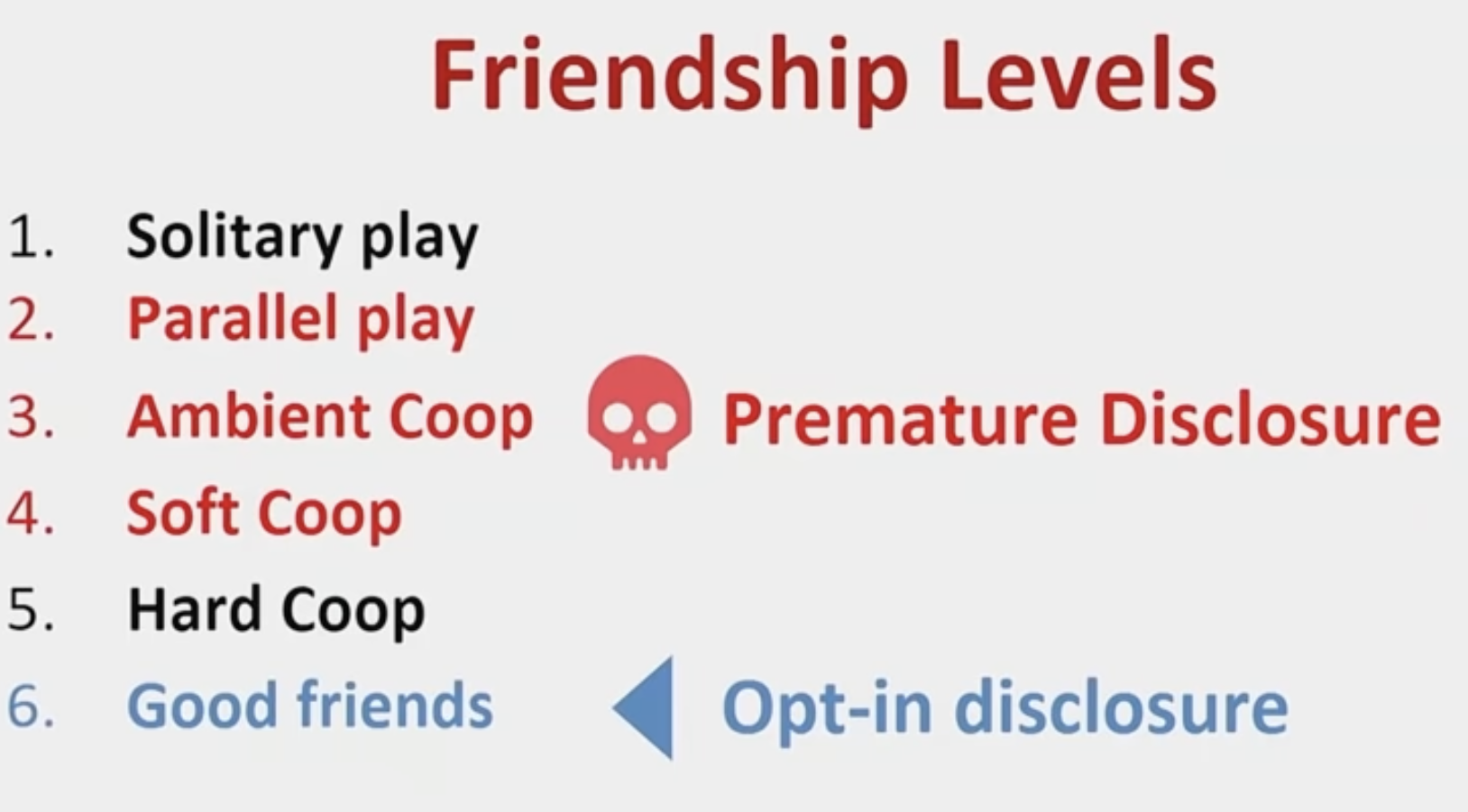
What I like about the pyramid is that each level integrates the levels below it. So when we're talking about disclosure we're really talking about how friendship is the product of proximity, similarity, reciprocity and finally disclosure. Can't jump to disclosure without the early stages. In this sense, it's very developmental in nature.
Let's take a broader look now at the concept of friendship leveling-in
I think that the image below is pretty self-explanatory. There's different levels of friendship from solitary play to friends. Along these levels, friends work their way up the friendship laws from the bottom of the pyramid to the top.

- Friends interact along all of the friendship levels
- Ambient coop: when you get points in a game just for being in the vicinity of someone who earned the points through some action; can segue into soft coop, learn that if we work together, not just ambiently, we can earn even more points together.
- Need game dynamics that enable all levels of friendship, at all times
The image below gets at the game features or focus of game play that should happen along side the levels of friendship--a kind of "intimacy leveling-in". Good caveat that real friends, people you know prior to engaging in the game, they get to skip some steps. This makes intuitive sense.
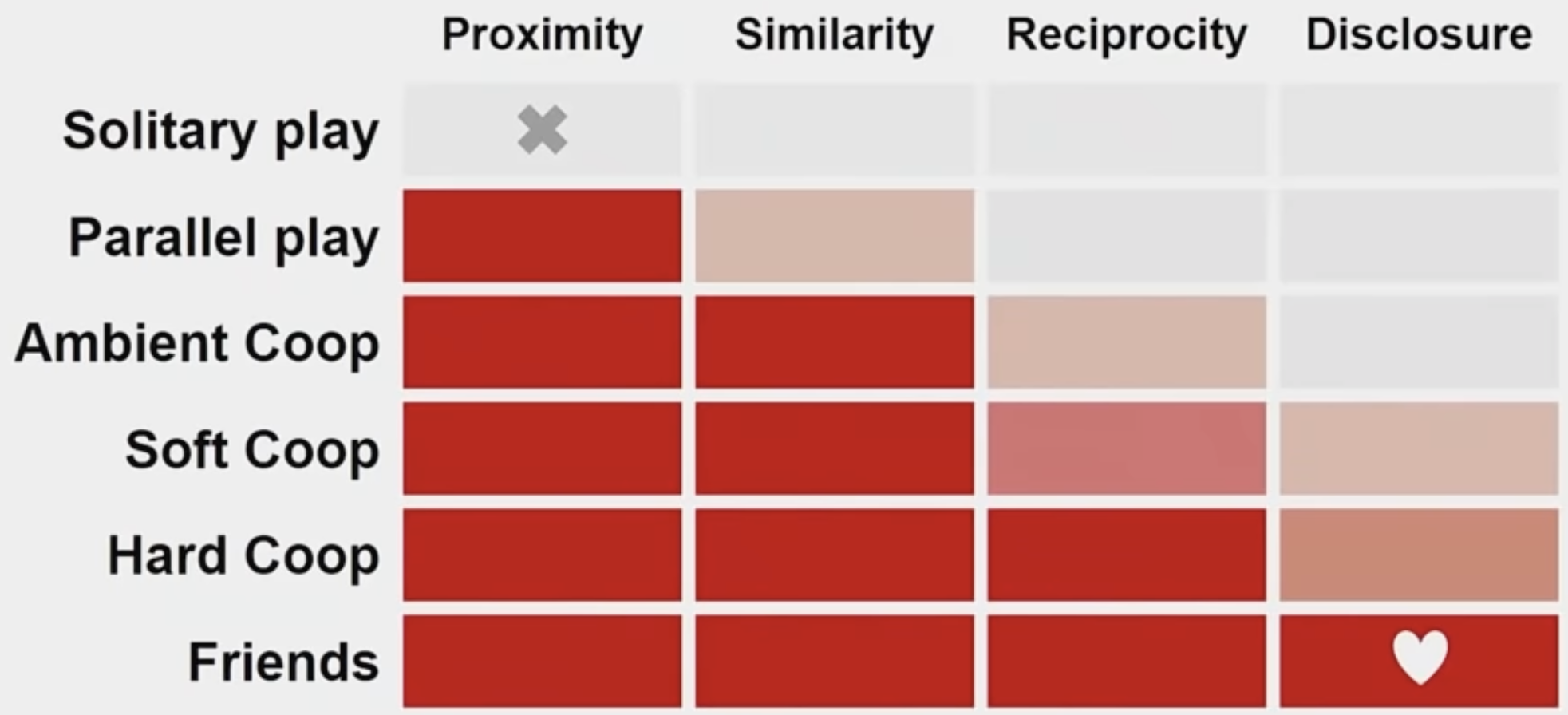
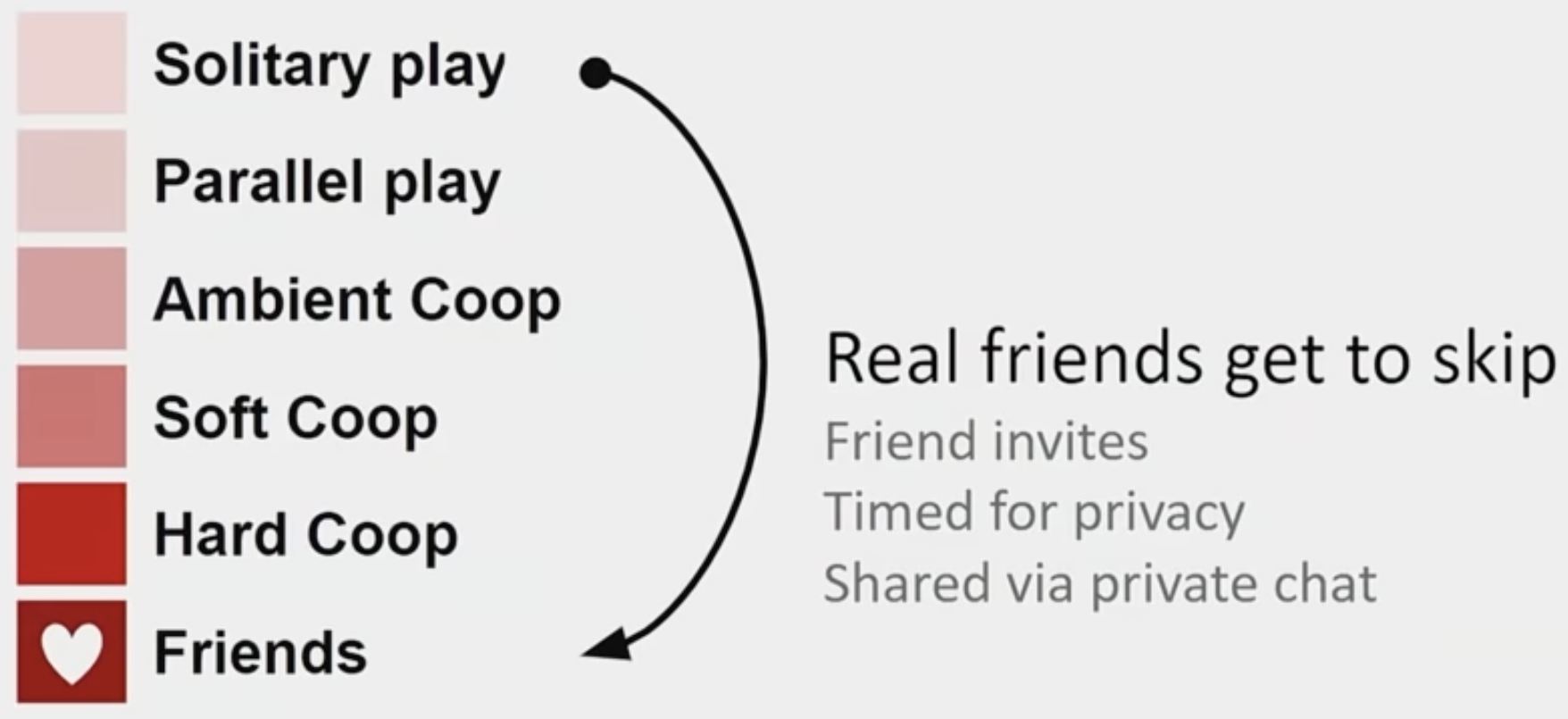
And last but not least - looking at the 4 laws of friendship and the different levels of friendship. Again, there's a developmental, or growth, lens to view friendship with. It's something that builds over time.
- For example, if you're designing for parallel play and have a high level of disclosure, this isn't a great idea - it may backfire.
